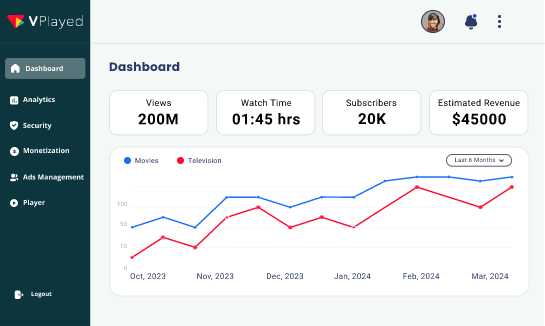Video Transcoding: 7 Best Practices To Achieve High Quality In Videos
With our advent into an advanced and digitized world, the media and entertainment industry are surely at an advantage the most. But at the same time, they are the ones that have the pressure to keep up with the latest trends even before they launch.
Basically, if you don’t know squat about technology in your market, then you will get buried in the noise.
One of the biggest markets there is today is the video streaming platform market. And as much fun it looks from the outside, it is the one which is most competitive. In order to stay ahead of the curve, high end algorithms need to be put in place which may or may not improve the process by 1-2%.
But that 1-2% makes all the difference.
Some of the top players in this game deal with keeping the quality of the video high without compromising user experience. Consumer eyes are trained better than ever, they can make out even the slightest differences in quality. Also, people need everything fast, so if there’s even the slightest delay over the expected time in which a video should start, they’ll leave the VOD platform, never to return.
Transcoding is the process which governs how quickly a video starts streaming. Let’s get into the deets of it.
Table of Contents
What is Video Transcoding?
Simply put, Video transcoding is the process of converting a video file from one digital encoding format to another.
A transcode is made from taking an encoded piece of video and then converting it into one or more newly and more compressed streams that can then be played in a player on a computer or mobile device depending on the settings and methods used.
Adaptive Bitrate Streaming (ABS) is a phenomenon which depends on transcoding. Let’s say a raw video is compressed from 80mbps to 4kbps bitrate which can be streamed seamlessly at a certain bandwidth. For people having an internet connection lower than that bandwidth, the video will be patchy and will show lag. Such data-strapped conditions require the video to be encoded at a lower bitrate.
Even then, if the same video is encoded again at a lower bitrate, how is the platform supposed to know which file to run for that device: the one with a lower bitrate or the one with the higher bitrate? Without an automating algorithm, you’ll be left with an extra encoded file in your cloud which would have no use.
ABS senses the bandwidth on a device and selects the video with the most appropriate bitrate for that bandwidth, thus providing an uninterrupted viewing experience at most internet speeds.
While it sounds easy, efficient transcoding is a professional’s game. Transcoding in itself is quite costly, so not every video can be encoded across every possible bitrate. It would be a waste of time and money. This is where marketing analysis comes in. You only need to transcode specific videos in those bitrates that’ll work on devices owned by the majority of your target market.
If your target market owns high-end devices with good quality playback, encoding at higher bitrates only is recommended, and vice versa.
Best Practices In Video Transcoding
2-PASS VBR
While encoding high quality videos with variable scene types, it is recommended to use 2-pass VBR. Unlike CBR and VBR, 2-pass VBR has 2 stages (passes) of encoding:
- The first pass calculates the ideal bitrate needed for each keyframe of the video.
- The second pass renders the entire video depending on those bitrates.
In 2-pass VBR, keyframes are selected according to scene changes and a keyframe’s encoding process is dependent upon the preceding and the following keyframes. This makes 2-pass VBR quite useful for rendering high quality pro-recorded videos but pointless for live streaming purposes.
Bitrate Selection
It is essential that the right bitrate is chosen while encoding any video. This is especially true for CBR-encoded videos which encode only at the highest bitrate. In case of VBR, the variable bitrate should ideally be kept equal to the pixel width of the video.
Selecting the right bitrate also depends upon the type of video. Animated videos can produce high quality even at low average bitrates while action movies or movies with fast and dynamic changes usually encode at higher bitrates for high quality.
Eliminate Blocking Artifacts

Blocking artifacts, commonly known as ‘pixelation’, are caused by block transform coding which reduced video quality during compression. In order to reduce blocking artifacts, HEVC encoding efficiency needs to be improved, which can be done by choosing the horizontal and vertical frame size dimensions as multiple of 16.
Most Common Frame Size Dimensions
- 4:3 Aspect Ratio – 320×240, 480×360, 640×480
- 16:9 Aspect Ratio – 640×360, 1024×576, 1280×720, 1920×1080
Pay Attention to your Profile Settings
There are a lot of times that a video stops streaming suddenly or doesn’t stream at all. It always seems like a technical glitch and you end up tampering with your player backend and things deteriorate even further.
Instead, the first step should be to check your encoding profile settings on the transcoding platform dashboard. It is important to choose the correct settings for each video before encoding it. Assigning incompatible values can cause the video to malfunction at any point.
Use Progressive Scanning

If you watch or create videos, you surely might have heard or read “1080p” or “720p” somewhere. That “p” stands for progressive.
Progressive scanning, or non-interlaced scanning, is a way of storing and displaying still or moving images from a camera or on a screen where the entire image is captured in one frame in one go.
It is essential to understand that its predecessor, called interlaced scanning, did not do that.
In interlaced scanning, the image was divided into horizontal lines. The odd lines were scanned first for 20ms and then the even lines for the next 20ms. The amalgamation of these 2 fields created the entire frame.
The advantage of progressive scanning is that it gives a faster transcoding process and the resultant video is much smoother and has a higher degree of realism.
High Quality Master
It goes without saying that you need a high quality recording device to produce great content irrespective of the encoding processes and container formats.
High quality transcoding will never provide higher quality than the master video.
Avoid Dimensional Upscaling

Stretching a video beyond its source dimensions is not recommended.
During transcoding, if any video is scaled beyond the dimensions it was recorded in, it will get blurry and lose quality.
Conclusion
Transcoding is a tricky procedure and requires a slightly technical hand.
Follow these best video transcoding tips and tricks and you can get a better video from any transcoding platform. Creating engaging and high-quality content is not that difficult if you know what you’re doing. And even if you don’t, OTT solutions like VPlayed exist for assisting you with the same.
